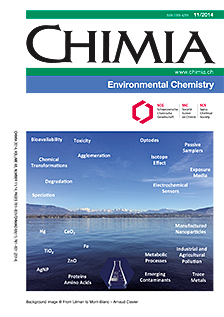Iron Biogeochemistry in Aquatic Systems: From Source to Bioavailability
DOI:
https://doi.org/10.2533/chimia.2014.764Keywords:
Carbon, Iron, Lake, Limitation, Ocean, PhytoplanktonAbstract
Iron (Fe) is an essential trace element for several key metabolic processes in phytoplankton; however Fe is present in low concentration in many aquatic systems including vast oceanic regions and large lakes. In these systems, Fe can limit the growth of phytoplankton and atmospheric carbon dioxide biological fixation. Indeed Fe limitation exerts a global impact on the carbon cycle and the imprint of aquatic systems on our climate. In order to understand how aquatic systems function and increase our ability to predict their response to changing conditions, it is therefore paramount to understand when and how Fe controls operate. This review presents the complex relationship between Fe chemistry and the biology of surface waters to highlight the parameters defining the forms of Fe that are accessible for phytoplankton growth (or bioavailable). Particular attention is given to the identification of Fe sources and Fe organic complexation as these, in conjunction with biological recycling and remineralisation, mostly control Fe residence time, chemistry and bioavailability.Downloads
Published
2014-11-26
How to Cite
[1]
L. Norman, D. J. E. Cabanesa, S. Blanco-Ameijeiras, S. A. M. Moisset, C. S. Hassler, Chimia 2014, 68, 764, DOI: 10.2533/chimia.2014.764.
Issue
Section
Scientific Articles
License
Copyright (c) 2014 Swiss Chemical Society

This work is licensed under a Creative Commons Attribution-NonCommercial 4.0 International License.







